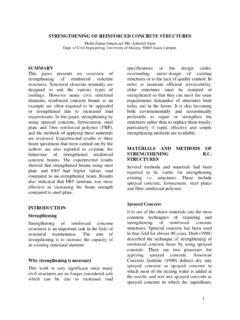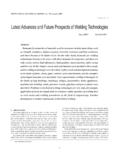Transcription of Microstructures and Mechanical Properties of …
1 Microstructures and Mechanical Properties of AustemperingCr Mo (SCM 435) Alloy SteelCheng-Yi Chen, Fei-Yi Hung+, Truan-Sheng Lui and Li-Hui ChenDepartment of Materials Science and Engineering, National Cheng Kung University, Tainan, Taiwan 701, R. O. ChinaSCM435 is a Cr Mo alloy steel and it is usually used to make the matrix of tempered-martensite by oil bath method, but it has someproblems about reliability in the thin plate specimens. This research used the austempering heat treatment on the SCM435 thin plate specimenwith a type of double loop and obtained the Cr Mo bainite structure, and then we could further investigate the Mechanical Properties of SCM435bainite materials. Experimental data showed that the stability of the Mechanical Properties of the specimen with austempering temperature 830 Cfor 25 min was better than that of 15 min.
2 The size of the austenite grains affected the strength of thin plate bainite specimen. After austemperingat 830 C for 25 min and salt bath at 290 C, the stability of the ultimate tensile strength (UTS) was better than that of the salt bath specimens at310 and 330 C. The average hardness of all the specimens was more than HRA70. The specimen with austempering at 830 C for 25 min andsalt bath at 290 C for 30 min had bigger grain size of the austenite and retained phase of vol%. It also had higher hardness and , the austempering SCM435 alloy was improved for tensile strength comparing with traditional oil tempered-martensite process.[ ](Received September 11, 2012; Accepted October 25, 2012; Published December 25, 2012)Keywords:SCM435, alloy steel , austempering , Mechanical properties1.
3 IntroductionThe SCM435 is a Cr Mo steel with high strength and highhardness Properties , and it has been widely used in themachine parts, shafts, gears and strength screw 3)However, this material often has lower reliability due to theinequality of brittleness in the high-temperature temperingand quenching. The austempering heat treatment can obtainthe uniform bainite structure to improve the brittlenessof tempering, and the austempering heat treatment is acontinuous process that it also has the efficiency anduniformity. For the thin plate specimens, the mechanicalproperties of bainite structure are better than the traditionalmartempering this study, the SCM435 sheet was made into the doubleloop-type thin plate specimens by punch-shear process tohighlight the stress concentration to study the effects ofthe ,4)The bainite structure has the excellentmechanical properties3,5,6)and it can reduce the brittlenesseffect of the thin plate specimen (improve the strength andductility) by controlling the different phases of matrix(the retained austenite content).
4 According to the reference,7)the characteristics of austempering SCM435 still not havebeen studied and the salt meet the environmental , this research controlled the heat treatmentconditions to obtain the different bainite structures ofSCM435 alloy, and then investigated the tensile strengthand hardness to obtain the application data of Experimental ProcedureThe chemical composition of SCM435 is given in Table 1,the carbon content is mass%and contains the otheralloying elements such as Si, Cr, Mn. This research usesthe double loop-type thin plate specimen (t= mm) tohighlight the brittle effects of SCM435 alloy by punch-shearprocess. Figure 1 shows the geometric dimensions of thespecimen. The heat treatment conditions of the specimen was830 C (vacuum) holding 15 and 25 min for austenitisation,and then made it in the salt bath furnace immediately fortempering.
5 The salt bath conditions were placed on eachconstant temperature of 290, 310 and 330 C for 30, 60and 120 min, then quench in the water. Each austemperingcondition was calledx C-y m by the salt bath condition,such as 290 C-30 characteristics of each austempered specimens aredetermined quantitatively by SEM (Hitachi SU8000) andimage analyzer. The structure phases were identified by XRD(Bruker AXS Gmbh, Karlsruhe, Germany). The hardnessmeasurement (HRA) and the tensile Properties (tensile rate:1 mm 1 min 1) of each specimens were evaluated in thebrittleness effect. In addition, using ESCA (Electron Spec-troscopy for Chemical Analysis, PHI 5000 Versa Probe)analyzed the surface to clarify the characteristics ofcompounds in the SCM435 bainite 1 The chemical composition of the SCM435 (mass%).
6 CMnSi P S Al 1 The configuration of the thin plate double loop specimen.+Corresponding author, E-mail: Transactions, Vol. 54, No. 1 (2013) pp. 56 to 60 2012 The Japan Institute of Metals3. Results and DiscussionFigure 2 shows the Microstructures of the austemperedbainite specimen (830 C for 15 min) with the different saltbath conditions. Compared with previous other systems,5,8 10)the microstructure of SCM435 alloy wasfiner (similar heattreatment condition) and it was a close relationship withthe alloying elements (carbon content). When austemperingduration extended from 15 to 25 min, the bainite structurehad a coarsening phenomenon (Fig. 3) and it was becausethe austenite grain growth.
7 In other words, increasing theaustempering duration of SCM435 specimens, we can obtainthe thick and feathery bainite spectra of the different salt bath conditions afteraustempering 15 and 25 min are showed in Figs. 4 and 5. Thefigures show the peak angles are the same and the phases areconsist of the bainitic ferrite, carbides and retained phase. During salt bath process, the retained phases form inmatrix due to the diffusion of carbon. In addition to the peaksof the bainite structure, there is no other obvious peak andwe can confirm the SCM435 structure to transform into thebainite matrix fully after austempering heat 6 shows the comparison of tensile mechanicalproperties of the different salt bath conditions afteraustempering at 830 C for 15 min.
8 UTS of the specimen at330 C is significant decreased with increasing the holdingtime (reduce to 950 MPa) and the tensile fracture resistanceof specimen at 330 C for 120 min was the lowest. In termsof hardness, no matter the conditions of salt bath 30 minor 60 min, the hardness was about HRA72. Furthermore,increasing salt bath temperature of specimens would decreasethe hardness of the structure. The main reason is the coarsebainite structure and higher retained phase ,5,9 11)Also, this result can confirm the content of precipitationcarbide is lower with higher salt bath temperature andlonger tempering duration, so there is no significant contri-bution to the strength and hardness of the bainite 7 shows the comparison of Mechanical propertiesof the different salt bath conditions after austempering at830 C for 25 min.
9 The data at 310 and 330 C is unstable. Thetensile strength of the specimens at 290 C is reach 1100 MPaand has a better reliability than the other specimens. Forhardness analysis, the specimen at 330 C is more stablethan other two salt bath conditions (290 and 310 C). Thehardness values are about HRA72 and the carbides in thematrix are distributed uniformity. According to results ofFigs. 6 and 7, the specimen is austempered at 830 C for15 min and precedes the salt bath heat treatment at 290 Cthat has more stable tensile strength and hardness. It can beexplained that the salt bath conditions is more importancethan austempering time for the bainite structure of salt bath condition is the closest relationship for themechanical Properties , so the failure mechanism of thespecimens at 290 and 330 C are compared to understandbrittle effects of thin plate ,8)Figure 8 is thefracture characteristics of the specimens after each salt bathheat treatments.
10 In Fig. 8(a), we observe the dimple structureand confirm the characteristics of ductile failure. In Fig. 8(b),(a) (b)(c) (d)Fig. 2 Microstructural characteristics of the austempered specimen (830 C-15 min) with the different salt bath conditions: (a) 290 C-60 min (b) 290 C-120min (c) 330 C-60 min (d) 330 C-120 and Mechanical Properties of austempering Cr Mo (SCM 435) Alloy Steel57(a) (b)(c)(d)Fig. 3 Microstructural characteristics of the austempered specimen (830 C-25 min) with the different salt bath conditions: (a) 290 C-60 min (b) 290 C-120min (c) 330 C-60 min (d) 330 C-120 angle, 2 / degree Intensity ( )Fig. 4 XRD of the austempered specimen (830 C-15 min) with thedifferent salt bath angle, 2 / degree Intensity ( )Fig.












